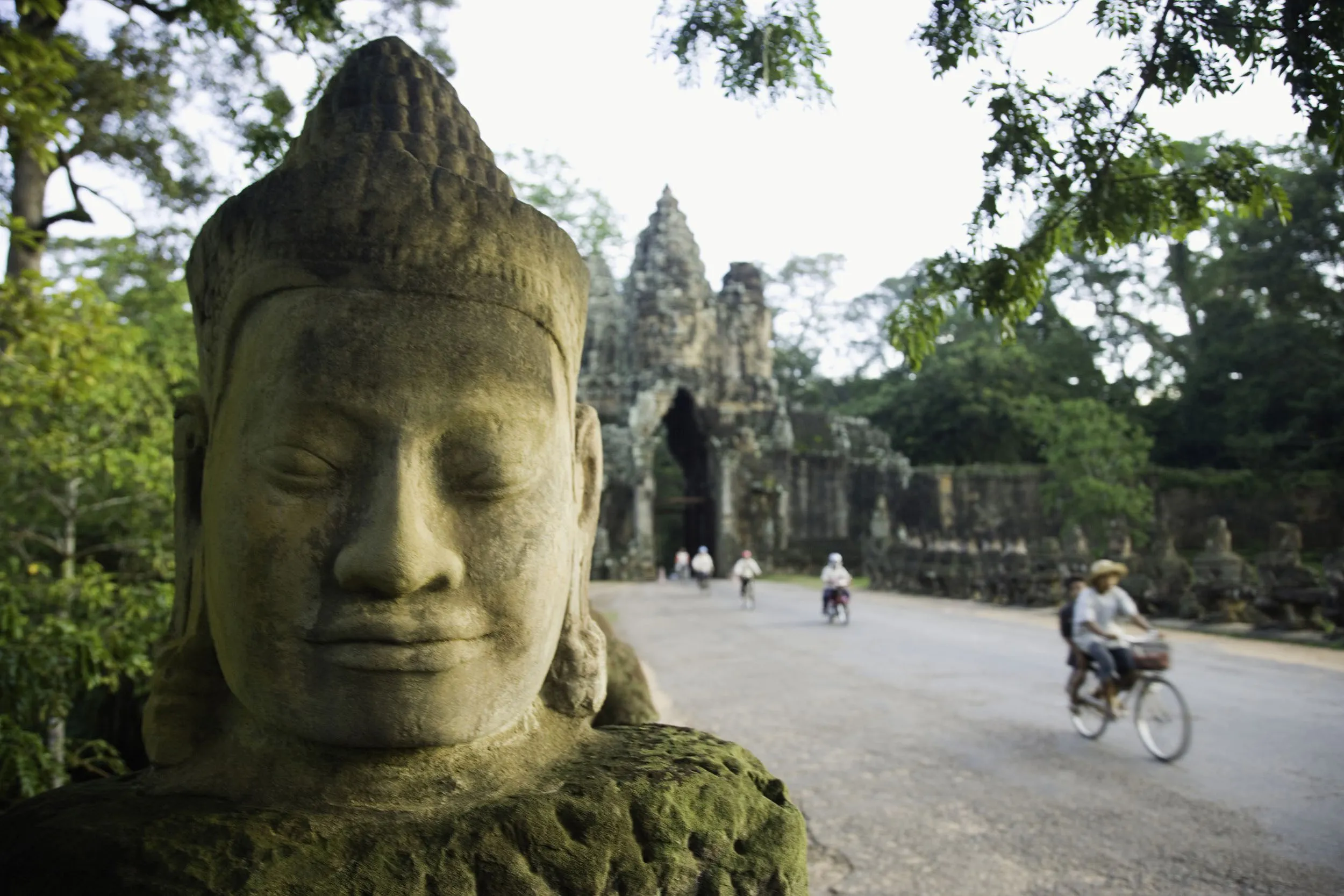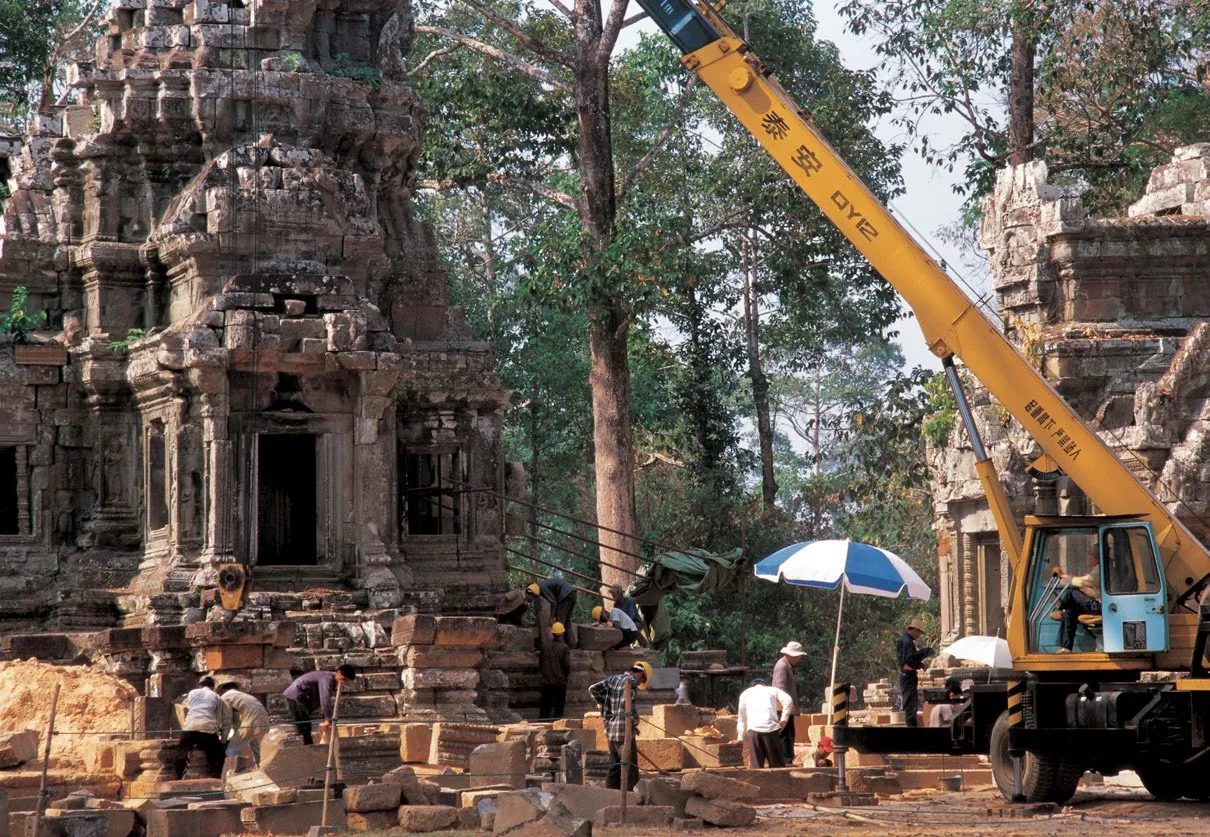KEEPING THE KHMER SMILE AT ANGKOR WAT
2018-07-28ByWangFang
By Wang Fang
A UNESCO World Cultural Heritage Site, the historical Angkor temple complex consistently attracts tourists from all over the world. The spectacular statues of smiling Buddha faces at Angkor Wat compose a particularly popular attraction. However, the site has gradually disintegrated with age.It is in urgent need of protection.
China is a big country rich in cultural heritage. It has joined a global effort to protect and restore the site. The Chau Say Tevoda temple and the Ta Keo temple have been protected and restored with Chinese assistance.After 10 years of hard work,Chinese cultural relics experts handed over Chau Say Tevoda to the Cambodian government in 2008. The Ta Keo restoration project that kicked off in 2011 will be completed in August this year.
The Royal Palace at Angkor Thom, an important site in Khmer history, will also be restored by Chinese relics experts.
China’s Role in the Global Effort
The historical site of Angkor is located in Siem Reap Province.It is a temple complex built in what was then the city of Angkor, capital of the Khmer Empire from the 9th to 15th centuries. Due to ravages of war and natural erosion, Angkor Wat was listed as a UNESCO World Heritage Site in 1992. In 1993,the Cambodian government and UNESCO launched an appeal to the international community to help save Angkor.The International Coordinating Committee (ICC-Angkor) was set up to coordinate the global effort of 30 different countries and organizations to safeguard and develop the historical site.
China was one of the first to participate in the effort. Since 1998, the Chinese Government Team for Safeguarding Angkor(CSA), powered by the Chinese Academy of Cultural Heritage(CACH), has successively carried out conservation and restoration on Chau Say Tevoda and Ta Keo.
Why did China choose Chau Say Tevoda as the first project? “The protection and restoration of the Angkor temples is a complicated project that involves local culture and religion as well as restoration of the buildings themselves,”explained Yuan Mengqian,a cultural relics researcher with the CACH. “It was our first chance to participate in a global relics restoration effort. Considering the overall situation, we started with Chau Say Tevoda, a small to mediumsized temple.”

A statue at the south gate of Angkor Thom, Cambodia.
ICC-Angkor confirmed that“the concepts and methods of protection and restoration of the five sanctuaries of the mountain temple fully conform with the relevant provisions and requirements of Angkor Charter.”

Chinese Government Team for Safeguarding Angkor at work on Chau Say Tevoda on February 2, 2004.
However, a modestly-sized project did not guarantee an easy job. “Chau Say Tevoda was the first restoration project for Chinese relics experts to launch in Cambodia, so it was particularly challenging,”admitted Huang Wenlan, a research fellow with CACH.“Parts of the building had collapsed and were buried under more than a meter of dirt and mud. Trees and weeds were growing wantonly in the building. About 5,000 stones from the building were scattered around the temple.” Huang said it is extremely difficult to return such stones to the original structure.
According toAngkor Charter,a document on the ethics and practice of conservation at Angkor, each intervention should, as much as possible, respect the original concept. This is also the principle of the conservation and restoration of Chinese cultural relics. Following this principle,the CSA drew on the experience of “Critical Reconstruction” to restore the scattered stones to their original positions.
Having succeeded at Chau Say Tevoda, the CSA began to work on the second phase of the project, Ta Keo. “Ta Keo starkly contrasts with Chau Say Tevoda,” explained Yuan. “It is a massive mountain temple with five sanctuaries placed atop a 22-meter-high five-step pyramid. It’s quite difficult and challenging to restore sanctuaries within the limited space on top of the pyramid.”The CSA strictly abides by the principle of minimal intervention, appropriate materials, reversible methods and full documentation of all work performed. The efficiency of its work has been applauded by all stakeholders.
“The restoration of Chau Say Tevoda was a good warmup for Ta Keo,” said Huang.“The CSA carried out a more comprehensive and indepth investigation and study of the building, which involved architecture, history,archaeology, geology, material science, structural science,geotechnical science and conservation science.” Huang believes the CSA improved its knowledge and capability with this project.
ICC-Angkor con firmed that“the concepts and methods of protection and restoration of the five sanctuaries of the mountain temple fully conform with the relevant provisions and requirements ofAngkor Charter.”

Chinese Government Team for Safeguarding Angkor began working on Ta Keo in 2011.The project is expected to be completed this August.
Upgraded Cultural Relics
During the restoration,the CSA helped Cambodian experts train local technicians and workers. They also helped develop the tourism industry to benefit the local population.
“Except for experts and technicians from China, the entire work force was drawn from the local labor market,which created many jobs for the local population,” said Yuan.“We also cooperated with the Department of Archaeology of the Royal University of Phnom Penh to conduct technical and safety training for workers at Ta Keo. With the training and skills they acquired, local workers should be able to find more job opportunities with other projects in the Angkor region.
“According to my colleagues who have been working in the area for a long time, there weren’t many tourists in Ta Keo,” added Huang. “The volume of visitors to Ta Keo has been increasing, and the temple has become more popular in the region.”
Huang believes that during the process of conservation and restoration, understanding of the value of cultural relics will improve as the damaged buildings are restored.“Through conservation and restoration, we have gained a better understanding of the value and cultural connotations of Ta Keo,” Huang illustrated.After completion of the project,the CACH will host a series of exhibitions to show visitors the contrast of Ta Keo before and after the restoration and to explain its cultural background and significance.
Yuan has worked at Ta Keo for a long time, during which she got to know a Cambodian worker in his 70s who rode a motorcycle for nearly an hour every day to work at the temple. At first, Yuan suspected financial difficulties at home motivated him to make the commute every day. Eventually,she discovered he was from a well-off family and chose to work on the restoration simply because he grew up in Angkor and has deep feelings about the relics. “It is an honor for me to participate in the restoration of Ta Keo,” he declared. “The CSA has done an outstanding job in restoring such a massive temple in such a short period of time.”

Next, the CSA will restore the Royal Palace at Angkor Thom, which presents a whole new challenge. “The Royal Palace is located at the center of Angkor Thom, a key location,but the buildings are more diverse, including galleries,pools, terraces, walls and basreliefs,” said Huang. The Royal Palace used to be the center of the political and cultural life of the royal family. But most of the buildings and base sites are buried under the cultural layers and natural accumulation without much information on their layout and function. The archaeological research of the project is of great significance for the study of Khmer history.“Cambodian authorities have agreed to delegate the core of the historical site work to the CSA, which evidences their confidence in the Chinese experts and their satisfaction with the work that they have done thus far,” Huang adds with a smile.
Huang revealed that they will explore a new model of conservation-plus-restoration at the historical Royal Palace. It will be a comprehensive project integrating archaeological excavation, protection and restoration of structures,bas-reliefs conservation,biological disease prevention and treatment, laboratory construction, talent cultivation and cultural exhibitions. “We hope this will set an example for conservation of other Angkor sites,” Huang added.
